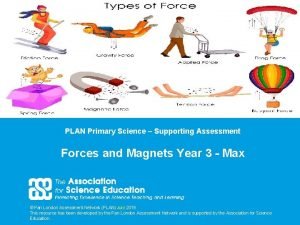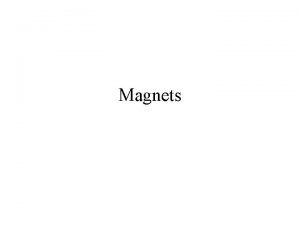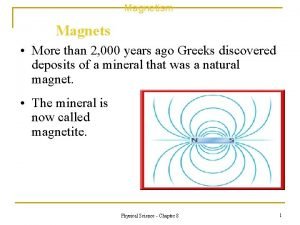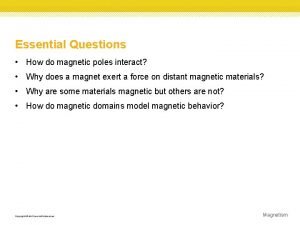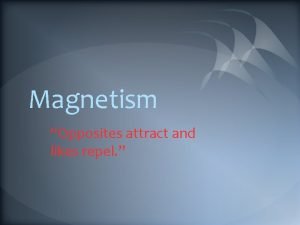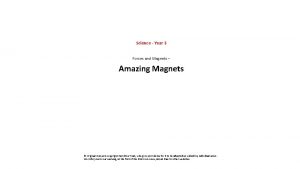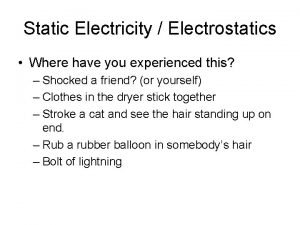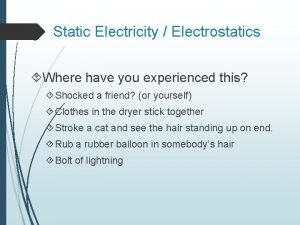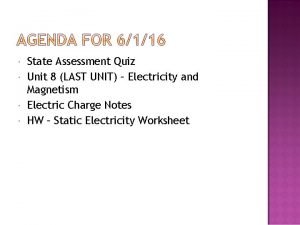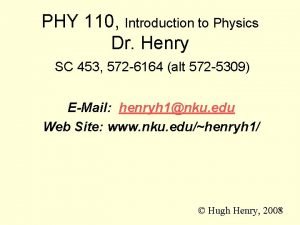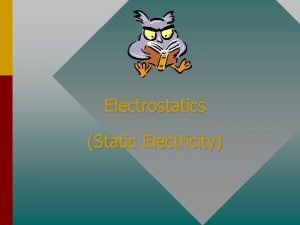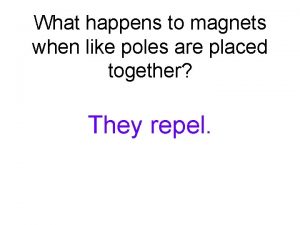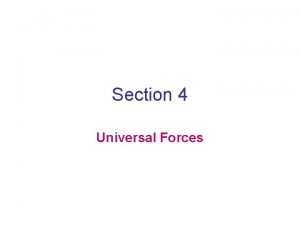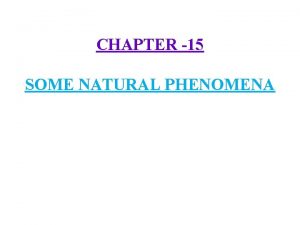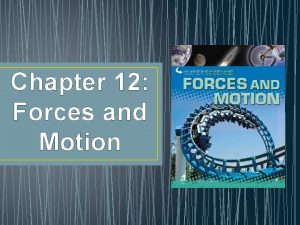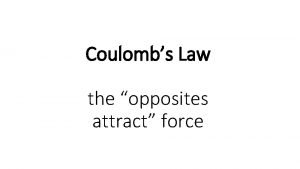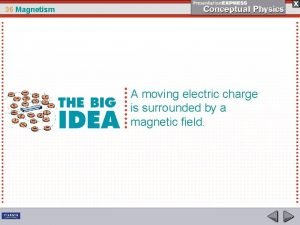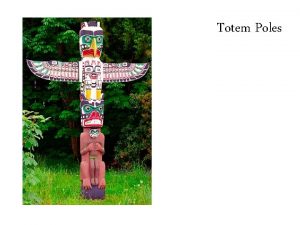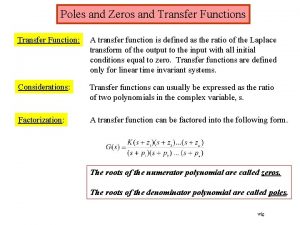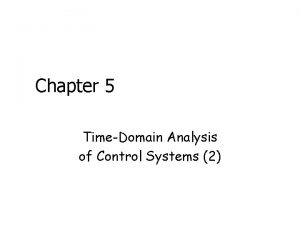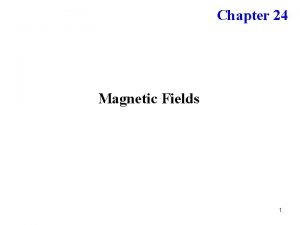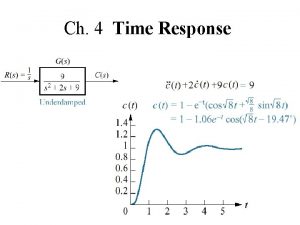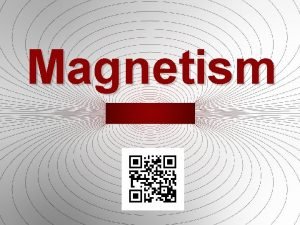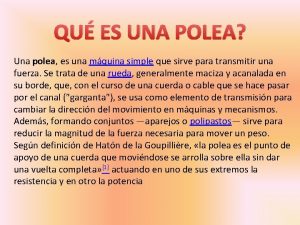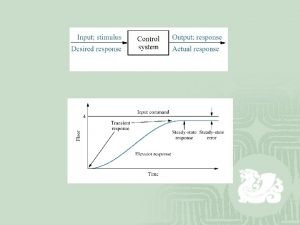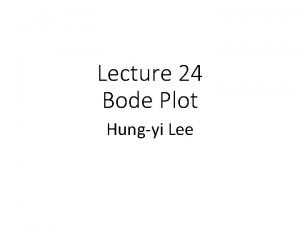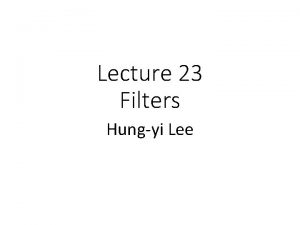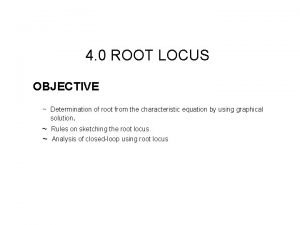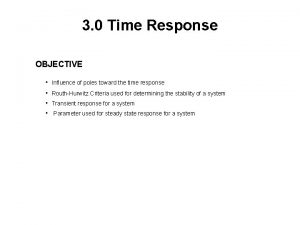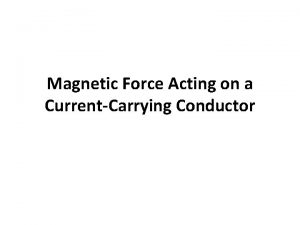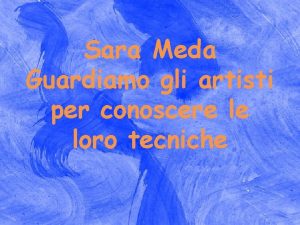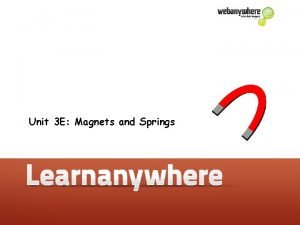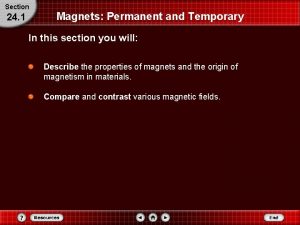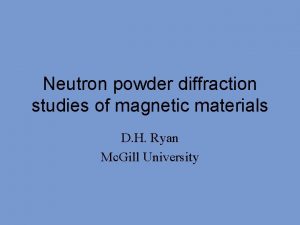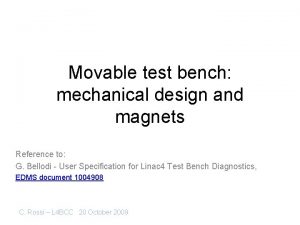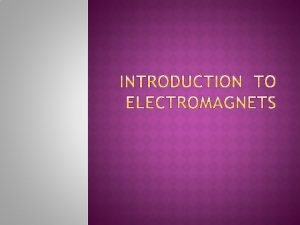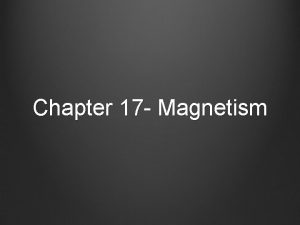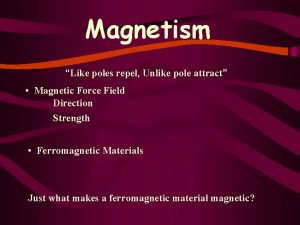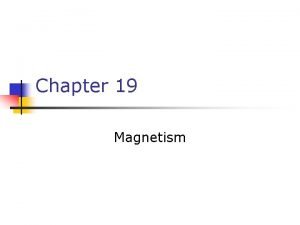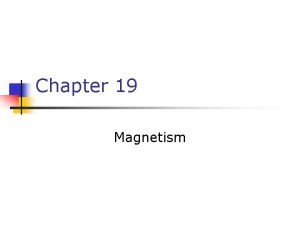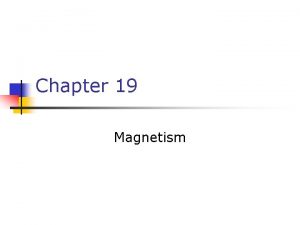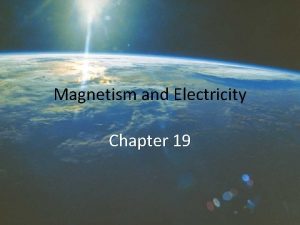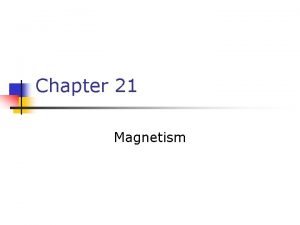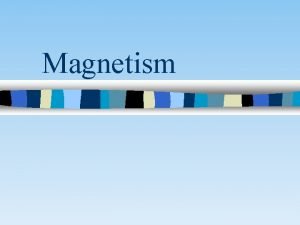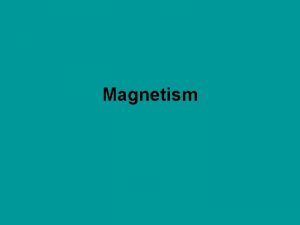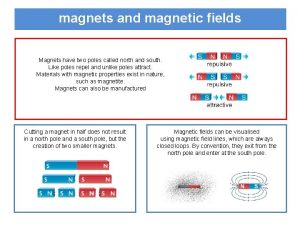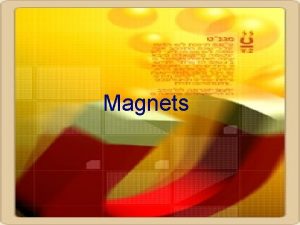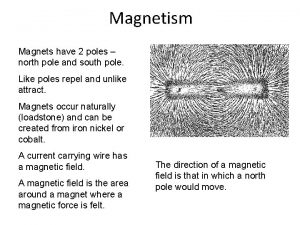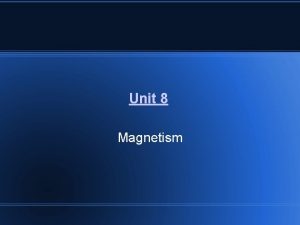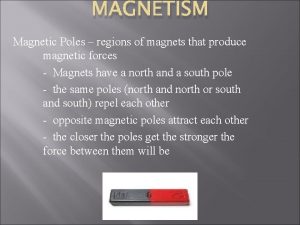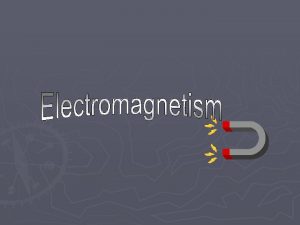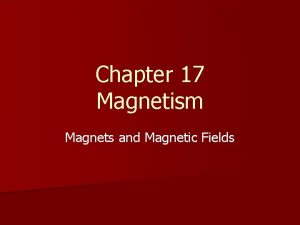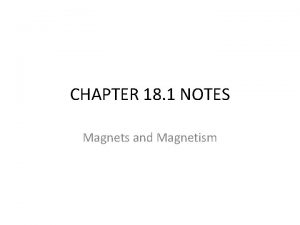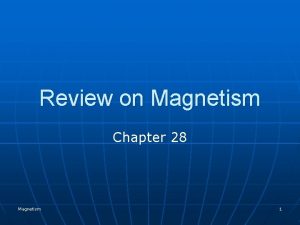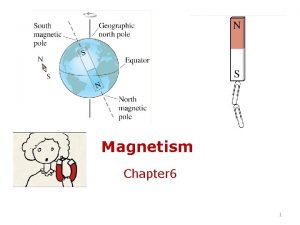Chapter 24 Magnetism For magnets like poles repel









































- Slides: 41

Chapter 24 Magnetism

For magnets, like poles repel each other and unlike poles a. b. c. d. also repel each other. attract each other. can disappear into nothingness. can carry a lot of energy.

For magnets, like poles repel each other and unlike poles a. b. c. d. also repel each other. attract each other. can disappear into nothingness. can carry a lot of energy.

The source of all magnetism is a. b. c. d. tiny bits of iron. tiny domains of aligned atoms. the motion of electrons. small lodestones.

The source of all magnetism is a. b. c. d. tiny bits of iron. tiny domains of aligned atoms. the motion of electrons. small lodestones. Comment: This is true for electrons moving in a beam or electrons spinning or orbiting the nuclei of atoms such as iron.

A strong magnet lifts a paper clip. Compared with the force the magnet exerts on the clip, the force the clip exerts on the magnet is a. b. c. d. much less. slightly less. the same. slightly more.

A strong magnet lifts a paper clip. Compared with the force the magnet exerts on the clip, the force the clip exerts on the magnet is a. b. c. d. much less. slightly less. the same. slightly more. Explanation: This is Newton’s third law. In the interaction between the paper clip and the magnet, both forces are equal and opposite.

Magnet A has twice the field strength of Magnet B. When brought close together, the magnet that pulls harder on the other is a. b. c. d. Magnet A. Magnet B. Both forces are equally strong. dependent on their distances apart.

Magnet A has twice the field strength of Magnet B. When brought close together, the magnet that pulls harder on the other is a. b. c. d. Magnet A. Magnet B. Both forces are equally strong. dependent on their distances apart. Explanation: This is Newton’s third law–the force that A exerts on B is equal and opposite to the force that B exerts on A.

Surrounding moving electric charges are a. b. c. d. electric fields. magnetic fields. Both of these. None of these.

Surrounding moving electric charges are a. b. c. d. electric fields. magnetic fields. Both of these. None of these. Comment: Don’t forget that electric fields surround electric charges!

The magnetic domains in a magnet produce a weaker magnet when the magnet is a. b. c. d. heated. dropped on a hard surface. Either of these. None of these.

The magnetic domains in a magnet produce a weaker magnet when the magnet is a. b. c. d. heated. dropped on a hard surface. Either of these. None of these.

Magnetic domains occur mainly for materials composed of a. b. c. d. carbon. copper. silver. iron.

Magnetic domains occur mainly for materials composed of a. b. c. d. carbon. copper. silver. iron.

A bar magnet that holds a chain of paper clips illustrates a. b. c. d. magnetic field displacement. magnetic induction. electromagnetic induction. Faraday’s law.

A bar magnet that holds a chain of paper clips illustrates a. b. c. d. magnetic field displacement. magnetic induction. electromagnetic induction. Faraday’s law.

When a bar magnet is broken in half, the magnetic strength of each piece is a. b. c. d. less than half. about half. the same. somewhat increased.

When a bar magnet is broken in half, the magnetic strength of each piece is a. b. c. d. less than half. about half. the same. somewhat increased. Explanation: This is detailed in Figure 24. 7 in the textbook.

A superconducting electromagnet makes use of a. b. c. d. low-resistance coils of wire. super-high temperatures. high-speed electrons. close packing of high-density magnetic domains.

A superconducting electromagnet makes use of a. b. c. d. low-resistance coils of wire. super-high temperatures. high-speed electrons. close packing of high-density magnetic domains.

The magnetic field lines about a current-carrying wire form a. b. c. d. circles. radial lines. eddy currents. spirals.

The magnetic field lines about a current-carrying wire form a. b. c. d. circles. radial lines. eddy currents. spirals.

A magnetic force cannot act on an electron when it a. b. c. d. is at rest. moves parallel to magnetic field lines. Both of these. None of these.

A magnetic force cannot act on an electron when it a. b. c. d. is at rest. moves parallel to magnetic field lines. Both of these. None of these. Explanation: A force is exerted on charged particles only when they move at an angle to magnetic field lines. The force is greatest when motion is at right angles to the magnetic field.

A magnetic force acts most strongly on a current-carrying wire when it a. b. c. d. carries a very large current. is perpendicular to the magnetic field. Either or both of these. None of the above.

A magnetic force acts most strongly on a current-carrying wire when it a. b. c. d. carries a very large current. is perpendicular to the magnetic field. Either or both of these. None of the above.

The fact that a force is exerted on a current-carrying wire in a magnetic field underlies a. b. c. d. motors. electric meters. Both of these. None of these.

The fact that a force is exerted on a current-carrying wire in a magnetic field underlies a. b. c. d. motors. electric meters. Both of these. None of these.

An electric meter operates on the principal that a current-carrying wire or coil will a. b. c. d. interact with a magnetic field. deflect away from a magnetic field. be attracted to a magnet. induce a magnetic field when near a magnet.

An electric meter operates on the principal that a current-carrying wire or coil will a. b. c. d. interact with a magnetic field. deflect away from a magnetic field. be attracted to a magnet. induce a magnetic field when near a magnet.

Surrounding our Planet Earth are a. b. c. d. radiation belts. cosmic rays. gravitational and magnetic fields. All of these.

Surrounding our Planet Earth are a. b. c. d. radiation belts. cosmic rays. gravitational and magnetic fields. All of these.

A magnetic force acting on a beam of electrons can change a. b. c. d. only the direction of the beam. only the energy of the electrons. both the direction and the energy. neither the direction nor the energy.

A magnetic force acting on a beam of electrons can change a. b. c. d. only the direction of the beam. only the energy of the electrons. both the direction and the energy. neither the direction nor the energy.

The magnetic field surrounding Earth a. helps shield us from cosmic rays. b. is likely caused by electric currents in its interior. c. changes over time. d. All of these.

The magnetic field surrounding Earth a. helps shield us from cosmic rays. b. is likely caused by electric currents in its interior. c. changes over time. d. All of these.

Earth’s magnetic poles and geographical poles occur a. b. c. d. atop each other. about 1000 miles apart. in northern Canada. beneath ice caps.

Earth’s magnetic poles and geographical poles occur a. b. c. d. atop each other. about 1000 miles apart. in northern Canada. beneath ice caps.

Magnetic materials are found in the bodies of a. b. c. d. bees. birds. bacteria. All of these.

Magnetic materials are found in the bodies of a. b. c. d. bees. birds. bacteria. All of these.
 Why do magnets repel
Why do magnets repel Why do magnets repel
Why do magnets repel Why do magnets repel
Why do magnets repel Groups of atoms with aligned magnetic poles are called
Groups of atoms with aligned magnetic poles are called Opposites attract magnets
Opposites attract magnets Magnets attract and repel
Magnets attract and repel First law of electrostatics
First law of electrostatics Like charges attract or repel
Like charges attract or repel What kind of circuit is this?
What kind of circuit is this? Like charges attract or repel
Like charges attract or repel Like charges attract or repel
Like charges attract or repel What happens when like poles are placed together
What happens when like poles are placed together What are forces
What are forces What universal force can repel as well as attract
What universal force can repel as well as attract Electron charge
Electron charge Repel
Repel Which universal force can repel as well as attract
Which universal force can repel as well as attract What law states that opposites attract
What law states that opposites attract Chapter 24 magnetism magnetic fundamentals answers
Chapter 24 magnetism magnetic fundamentals answers Chapter 36 magnetism answer key
Chapter 36 magnetism answer key Bumblebee totem pole
Bumblebee totem pole Poles of transfer function
Poles of transfer function Three person carry or stretcher lift
Three person carry or stretcher lift Control systems overshoot
Control systems overshoot How do similar (s-s or n-n) magnetic poles interact?
How do similar (s-s or n-n) magnetic poles interact? Underdamped response
Underdamped response Totem poles pictures
Totem poles pictures Magnetic field lines that curve away from each other show
Magnetic field lines that curve away from each other show Que e una polea
Que e una polea Underdamped poles
Underdamped poles Complex poles
Complex poles Ti webench
Ti webench Complex poles
Complex poles Complex poles
Complex poles A wire suspended vertically between the poles of a magnet
A wire suspended vertically between the poles of a magnet Sara meda
Sara meda Magnets for year 3
Magnets for year 3 Magnets and springs
Magnets and springs What happens if you break a magnet in half
What happens if you break a magnet in half Magnets for neutron diffraction
Magnets for neutron diffraction Amazing magnets
Amazing magnets Temporary magnet
Temporary magnet
